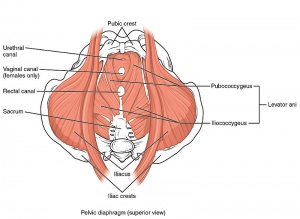Pelvic Floor and Other Pelvic Disorders
Original Editor - Laura Ritchie
Top Contributors - Laura Ritchie, Kim Jackson, Evan Thomas, Vidya Acharya, Nicole Hills and Rishika Babburu
Vulvodynia[edit | edit source]
Definition[edit | edit source]
Vulvar discomfort occurring in the absence of relevant visible findings or a specific, clinically-identifiable, neurological disorder.
Symptoms[edit | edit source]
- Burning
- Stabbing
- Stinging
- Itching
- Allodynia (light touch perceived as pain)
- Hyperalgesia (mildly noxious stimulus perceived as severely noxious)
- Functional limitation (e.g. pain during intercourse, using tampons, sitting)
Diagnosis[edit | edit source]
Symptoms should be present for 3-6 months before this diagnosis is considered.
Other conditions that should be ruled out include:
- Vulvovaginal candidiasis
- Bacterial vaginosis
- Trichomoniasis
- Genital herpes
- Neuropathic viruses (e.g. Herpes zoster)
- HPV
- Lichens simples chronicus
- Lichens simples sclerosus
- Lichens planus
- Contact dermatitis
- Atrophic vaginitis
- Squamous cell carcinoma
- Pudendal nerve injury
- Referred pain from sacral nerve roots after disc injury
- Neurologic disease (e.g. MS)
Classifications[edit | edit source]
Generalized vulvodynia:
- Almost constant, typically burning pain
- Affects the entire vulva
- Provoked (sexual, non-sexual or both)
- Unprovoked
- Mixed (provoked and unprovoked)
Localized vulvodynia / vestibulodynia:
- Localized to vulvar vestibule
- Burning / cutting pain at entrance of vagina
- Provoked (sexual, non-sexual or both)
- Unprovoked
- Mixed (provoked and unprovoked)
Co-Morbidities[edit | edit source]
- Interstitial cystitis
- Fibromyalgia
- Irritable Bowel Syndrome
- Depression
- Dyspareunia
- TMJ or facial pain
- Overactive pelvic floor
Dyspareunia / Vaginismus[edit | edit source]
Definition[edit | edit source]
Dyspareunia: Painful vaginal penetration in the absence of disease
Vaginismus: Inability to penetrate due to spasm of the muscles
Causes[edit | edit source]
- Painful scar / episiotomy
- Vulvodynia - Interstitial cystitis
- Protective response to infection, inflammation, injury or decreased estrogen or fear
Lichens Simplex[edit | edit source]
- Chronic irritation of the vulva
- Leads to itching, scratching and thickening of the skin
- Vulva can be weepy, causing moisture
Lichens Sclerosis[edit | edit source]
- Auto-immune disorder
- Itching or burning
- Skin with white patches
- Scars and adhesions of the vulva
- Easily bruised and torn
Lichens Planus[edit | edit source]
- Chronic mucocutaneous disease
- Itching or burning
- Scar adhesions
- On the vulva and in the vagina
- Affects other mucosal membranes e.g. oral, genital, esophageal - oral rash typically occurs first
- Significant pain
Desquamative Inflammatory Vaginitis[edit | edit source]
Definition[edit | edit source]
- Profuse discharge with irritation of the vulva and vagina
- Inflammation causes the vaginal wall to peel or shed (desquamation)
- No cancerous, contagious or bacterial origin known
Signs and Symptoms[edit | edit source]
- Pus-like yellow/green discharge
- May be vulvar burning and itching
- Usually no odour
- PAP smear may be abnormal
- No improvement with antibiotics or antifungals
Atrophic Vaginitis[edit | edit source]
- Decreased estrogen causes thinning of the vaginal epithelium leading to inflammation
- Can cause vaginal soreness, itching, and dyspareunia
- Sores and cracks can occur spontaneously
- Can have an odourous discharge
Interstitial Cystitis / Painful Bladder Syndrome[edit | edit source]
Go to this page for more information
Dysmenorrhea[edit | edit source]
Definition[edit | edit source]
Painful menstrual periods
Classification[edit | edit source]
Primary: Menstrual pain without pelvic pathology, onset shortly after menarche
Secondary: Pain associated with secondary pathology, onset may be years after menarche
Risk Factors[edit | edit source]
- Low BMI and low consumption of fruit, eggs and fish (for primary dysmenorrhea)
- Poor mental health
- Primary co-morbidities: irritable bowel syndrome, interstitial cystitis, vulvodynia, dyspareunia, TMJ and migraines
- Secondary co-morbidities: endometrioses, presence of intra-uterine device, pelvic inflammatory disease, uterine myomas and adhesions
- Smoking
Endometriosis[edit | edit source]
Definition[edit | edit source]
The abnormal presence of endometrial tissue outside of the uterus. This tissue implants and can behave in a similar manner to the uterus, shedding tissue and inflammatory molecules into the abdominal/pelvic cavity.
Symptoms[edit | edit source]
- Subfertility
- Pelvic pain including dysmenorrhea
Co-morbidities[edit | edit source]
- Irritable bowel syndrome
- Interstitial cystitis
- TMJ disorders
- Migraines
- Fibromyalgia
- Autoimmune disordersAutoimmune_Disorders
Anal Fissures[edit | edit source]
Definition[edit | edit source]
Tears in the mucosal membrane of the anal canal, usually extending from anal opening. Can become chronic and deep.
Signs and Symptoms[edit | edit source]
- Pain after bowel movement
- May notice bright red bleeding on toilet paper
Causes[edit | edit source]
- Stretching of anal mucosa beyond its capacity
- Constipation or prolonged diarrhea
- Trauma during childbirth
- Crohn's disease
- Anal sex
- Poor toileting in young children
Prostatitis[edit | edit source]
Category 1: Acute Bacterial Prostatitis[edit | edit source]
- Diagnosed through expressed prostatic excretions
- Symptoms may include fever/chills, prostate pain, dysuria, perineal pain, difficulty urinating (hesitancy), urinary retention, low back pain
Category 2: Chronic Bacterial Prostatitis[edit | edit source]
- Recurrent bacterial infection
- Diagnosed through expressed prostatic excretions
- Symptoms may include fever/chills, prostate pain, dysuria, perineal pain, difficulty urinating (hesitancy), urinary retention, low back pain
- Constant or intermittent symptoms that tend to be associated with the same bacteria
Category 3: Chronic Non-Bacterial Prostatitis[edit | edit source]
Category 3A: With inflammation[edit | edit source]
Category 3B: Without inflammation[edit | edit source]
- Also called Chronic Pelvic Pain Syndrome or Prostatodynia
- Symptoms may include pain (perineal, rectal, suprapubic, penile, coccygeal, groin, low back), pain radiating into testicles/scrotum/central perineal tendon/anus, burning, itchiness, muscle tension, pain during and after ejaculation, feeling as if sitting on a golf ball
- Urinary symptoms may include hesitancy, dysuria, nocturia, frequency and urgency, decreased stream, feeling of poor emptying
Category 4: Asymptomatic Inflammatory Prostatitis[edit | edit source]
- Inflammation found in the semen
Pelvic Floor Dysfunction in Women - Videos[edit | edit source]
| [1] | [2] | [3] |
Presentations[edit | edit source]
 |
Pelvic Physiotherapy - to Kegel or Not?
This presentation was created by Carolyn Vandyken, a physiotherapist who specializes in the treatment of male and female pelvic dysfunction. She also provides education and mentorship to physiotherapists who are similarly interested in treating these dysfunctions. In the presentation, Carolyn reviews pelvic anatomy, the history of Kegel exercises and what the evidence tells us about when Kegels are and aren't appropriate for our patients. |
References[edit | edit source]
- ↑ Health Alert USA. Pelvic Floor Dysfunction in Women part 1 of 3. Available from: http://www.youtube.com/watch?v=La54dC-0KH8 [last accessed 30/04/14]
- ↑ Health Alert USA. Pelvic Floor Dysfunction in Women part 2 of 3. Available from: http://www.youtube.com/watch?v=61teXduzmx4 [last accessed 30/04/14]
- ↑ Health Alert USA. Pelvic Floor Dysfunction in Women part 3 of 3. Available from: http://www.youtube.com/watch?v=k1E6s9St7v0 [last accessed 30/04/14]







